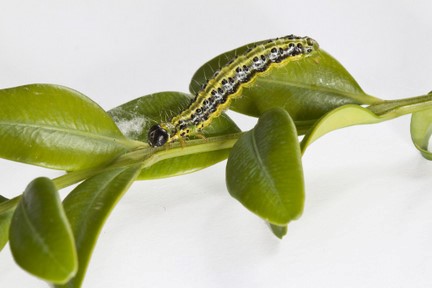Trees in a forest or landscape are under constant attack by insects and pathogenic diseases. A tree in good health can withstand most of these pests for awhile but can be overwhelmed as site conditions and pests relentlessly rob the tree of its vigour.
Box Tree Caterpillars
Box tree caterpillars are a relatively new threat to Britain’s trees. The first adult moths were discovered in 2008 but caterpillars were not found in private gardens until 2011. It has since become widespread in the London Boroughs of Wandsworth, Wimbledon and many other locations in this region.

A box tree caterpillar
Box tree caterpillars, such as the one above, feed within webbing and can completely defoliate box plants.
Gardeners are likely to become aware of box tree caterpillar when they find webbing and caterpillars on box plants.
Signs to look out for when checking for Box Tree Caterpillars
- The pale yellow flattish eggs are laid sheet-like, overlapping each other on the underside of box leaves
- Newly hatched caterpillars are greenish-yellow, with black heads. Older caterpillars reach up to 4cm (1¼in) in length and have a greenish/yellow body with thick black and thin white stripes along the length of the body
- The pupae are concealed in a cocoon of white webbing spun among leaves and twigs
- The adult moth usually has white wings with a faintly iridescent brown border, although the wings can be completely brown or clear. The moth has a wingspan of around 4cm (1¼in)
- The caterpillars eat box leaves and produce webbing over their feeding area. Plants may also show patches of dieback which may be especially apparent on trimmed plants. This is not to be confused with dieback caused by the disease known as box blight
What to do if you discover caterpillars on your Box Trees or Hedges
- Where practical, caterpillars can be removed by hand
- A pheromone traps can help monitor adult moth activity.
- A nematode biological control may have some effect on the larvae
Chemical control – treating a Box Tree Caterpillar infestation with insecticide
- Extensive infestations can be treated with an insecticide. Thorough spray coverage is required if control is to be achieved
- Forceful spraying is needed to penetrate silk webbing
- The contact pyrethroid insecticides pyrethrum (considered organic e.g. Bug Clear Gun for Fruit and Veg or Defenders Bug Killer,), deltamethrin (e.g. Bayer Provado Ultimate Fruit & Vegetable Bug Killer, Bayer Sprayday Greenfly Killer), lambda-cyhalothrin (e.g. Westland Resolva Bug Killer) may have some effect.
- The systemic neonicotinoid insecticide acetamiprid (e.g. Bug Clear Ultra) can also be used
- Plants in flower should not be sprayed due to the danger to pollinating insects
Need help with tree and shrub maintenance in South West London? Don’t hesitate to give us a call on the number above, we will be very happy to assist you!

